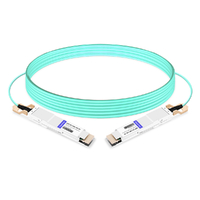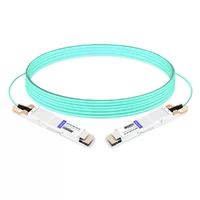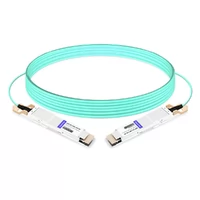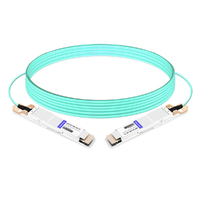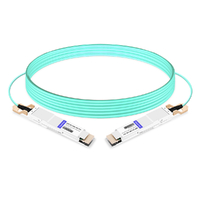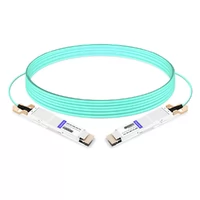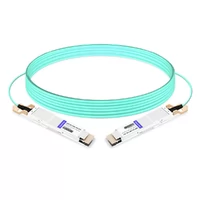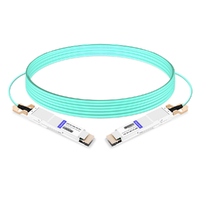Bandwidth requirements are increasing at an unprecedented rate in the fast-changing world of data centers. This calls for high data rates and reliable and efficient advanced connectivity solutions. To meet these needs, the 400G QSFP-DD Active Optical Cable (AOC) has become an essential component by introducing a new method to facilitate fast data transfer. This article aims to examine the technical specifications and working principles. It uses of 400G QSFP-DD AOCs in data centers so that readers can gain detailed knowledge about their function in improving network performance, minimizing latency, and maximizing infrastructure investments. We shed light on how active optical cables revolutionize future communication systems by looking into their specific features.
Table of Contents
ToggleWhat is a 400G QSFP-DD Active Optical Cable?
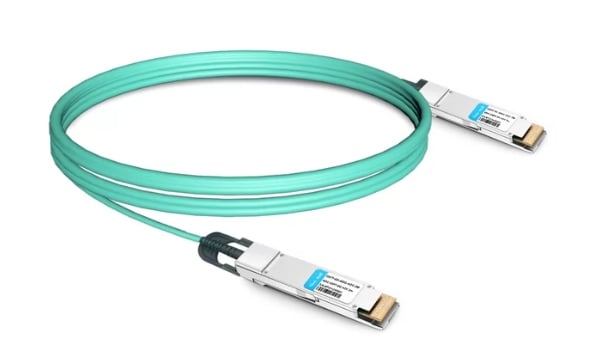
Understanding AOC Technology
Active Optical Cables (AOCs) are advanced optical cables with transceivers and optical fibers combined into one unit. AOCs use electrical-to-optical conversion to send data over longer distances than standard copper wires while maintaining high bandwidth capacities. Designed for 400 Gb/s data rates, the 400G QSFP-DD AOCs consist of four separate channels with a maximum distance of up to 100 meters on multimode fiber. These cables consume less power and have lower latency, which makes them perfect for data center applications where space is limited, and energy efficiency matters most.
Comparison with DAC: Differences and Benefits
Direct-attach copper (DAC) cables are often used in high-speed data transmission as a substitute for active optical cables. Although they both connect networking equipment, DACs and AOCs differ in technology, performance, and application scenarios.
One of the primary distinctions is construction. On the other hand, AOCs use optical fibers and integrated transceivers that allow them to transmit data over longer distances, up to 100 meters for 400G QSFP-DD variants, while DACs have a copper wire with a transceiver module at either end designed for short-distance connections, usually up to five to seven meters.
AOCs generally provide superior bandwidth capabilities from a performance perspective, providing data rates of four hundred Gb/s compared to that of DACs, which may support lower data rates ranging from commonly one hundred Gb/s type designs, among others. Besides this, they consume less power, making them more energy efficient when deployed in large numbers, thus further enhancing their advantage over DACS due to increased resistance against electromagnetic interference such that it ensures better signal integrity across vast distances.
In terms of deployment applications within equipment racks where short-range connections are preferred due to cost efficiency but high centers are required because data centers require higher rates over longer reaching areas than 400G QSFP DD AOC should be considered as it increases network performance scalability longevity infrastructure investments, therefore, choice between using either DAc or AOC depends on specific requirements needs budget considerations around networking operations.
Applications in Data Centers
In data centers, it is important to choose between Direct Attach Copper (DAC) and Active Optical Cables (AOC) in order to maximize performance and efficiency. Compared to AOCs, DACs are less expensive and easier to use which is why they are commonly used for short connections within server racks or between nearby devices. On the other hand, AOCs are used for long-distance data transmission, especially in high-performance computing and hyper-scale data center environments. More so, AOCs can support higher data rates at lower power consumption, making them suitable for high bandwidth applications such as 400G connections that handle huge amounts of data traffic. In addition, lightweight cables for improved airflow management in densely populated spaces within a data center save on operational costs while increasing energy efficiencies. Finally, DAC or AOC selection should be based on specific operational needs, budget factors, and infrastructure growth plans of any given organization’s data center facilities.
How Does a QSFP-DD to QSFP-DD Active Optical Cable Work?
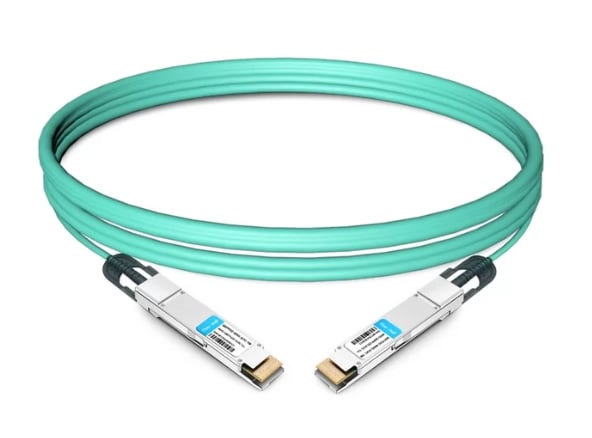
Components and Architecture
Several critical components make up a QSFP-DD to QSFP-DD Active Optical Cable (AOC).
- Transceiver Modules: These are located inside the connector and change electrical signals into optical signals and vice versa.
- Optical Fiber: Generally made of multimode fiber optics, it allows for high-speed data transfer over long distances.
- Cable Assembly: This comprises the outer jacket protection as well as strain relief features that promote flexibility and durability.
- Control and Monitoring Circuits: These provide real-time status information so performance can be monitored and heat managed properly.
To ensure minimal signal loss with maximum integrity during data transmission, this architecture has been created. It also has a modular design which makes it easy to integrate into current network environments.
Data Transmission Capabilities
QSFP-DD to QSFP-DD Active Optical Cables (AOCs) are distinguished for their wide data transmission capacity over long distances. These cables can transmit at a rate of 400 Gbps and above for lengths ranging from 100 meters to several hundred meters based on the type of optical fiber used. This technology is useful in environments that require large amounts of data to be transferred quickly, such as data centers and high-performance computing systems. Advanced transceiver technologies combined with optical fibers ensure minimal delay and less signal degradation which is important in ensuring the preservation of information in fast networks. Generally, AOCs offer strong solutions for modern networking infrastructure’s data transmission.
Interconnect Solutions in High-Density Environments
When it comes to high-density environments, the solutions we use for interconnecting must deal with rising requirements for bandwidth, reliability, and space efficiency. This means including modular cable assemblies like QSFP-DD and OSFP that allow different configurations while packing in more ports on switch systems or routers. Furthermore, using active optical cables (AOCs) can greatly lower weight and control heat generation, which are both vital considerations when working within restricted areas. Proper management of cables coupled with high-performance routing strategies further boosts system effectiveness, ensuring networks remain scalable and easy to manage. In addition, advanced optical technologies should be implemented. Hence, there is increased data throughput over longer distances without compromising signal integrity, thus making these solutions perfect for data centers and cloud computing infrastructures. Such an approach improves performance and adds up to overall operational efficiency in high-demand settings.
Why Choose 400G QSFP-DD AOC Over Traditional Cables?
Advantages in High-Speed Data Transfer
In high-speed data transfer applications, the use of 400G QSFP-DD Active Optical Cables (AOCs) over traditional copper cables has many advantages. Some of these are:
- Increased Bandwidth: Data rates as high as 400 Gbps can be supported by the 400G QSFP-DD AOC which enables it to transmit large datasets fast. This is critical in cloud computing and video streaming among other data-intensive applications where there’s a lot of information being transferred at once. It represents a huge leap from older technologies like Ethernet connections that only had speeds ranging between 10-25 Gigabits per second.
- Reduced Latency: For real-time applications such as online gaming or financial trading, low latency is essential. Compared to their copper counterparts, AOCs have significantly lower latencies, with studies showing that they can achieve less than one microsecond over short distances.
- Longer Reach: Signal degradation starts occurring when you’re trying to send data over long distances using wires but not with AOCs! Up to 100 meters without loss in quality means these bad boys are perfect for connecting servers and switches across sprawling data centers. Meanwhile, traditional copper solutions max out at around 30-50 meters before things get dicey.
- Lower Power Consumption: Operational costs go down when using an energy-efficient alternative instead of good ol’ fashioned metal wiring – plus Mother Nature will thank you too! When compared with standard cables, AOCs showed up to 40% savings which really adds up in large networks where lots of ports need powering.
- Lightweight & Flexible Design: Cable management systems love lightweight equipment because it makes installation easier for everyone involved! Dense environments become more navigable thanks to bendier options that don’t snap under pressure while routing through tight spaces – this could be crucial for high-density data centers.
For those who want top-notch performance and reliability from their networks, the new generation of network infrastructure is clearly pointing towards the use of 400G QSFP-DD AOC cables due to these features.
Reduced Signal Interference
In comparison to conventional copper cables, Active Optical Cables (AOCs) possess a natural ability to diminish signal interference. This is mainly because fiber-optic technology is used, which has lower vulnerability to electromagnetic interference (EMI). This feature becomes vital in places with elevated electrical noise, like data centers or industrial environments, since it guarantees data integrity and constant performance. Furthermore, AOCs utilize sophisticated materials coupled with shielding methods that additionally reduce the chances of crosstalk and outside disturbances, thus allowing dependable high-speed data transmission. As a result, AOCs are ideal for use in situations where keeping a clean signal is critical for operational achievement.
Lower Power Consumption
Active Optical Cables (AOCs) are known for being energy-efficient due to fiber-optic technology. Compared with traditional copper cabling systems, AOCs consume much less power. For instance, studies show that compared to copper cables operating at equal transmission speeds, AOCs can save about 30% to 40%. This reduced energy use is vital not just for cutting operational costs but also for minimizing the entire carbon footprint of data center activities.
The power efficiency of AOCs comes from their optical signal transmission which requires less energy to sustain signal integrity over long distances. On the other hand, as copper cables run longer, they suffer increased attenuation and degradation of the signals, requiring more power for boosting or regenerating those signals while maintaining high-speed data transfers across wider areas than copper does up to 100 meters and beyond without equivalent demands on electricity levels.
Moreover, given the increasing emphasis on sustainability and conservation within modern network infrastructures, lower power consumption by AOCs appears compatible with corporate goals aimed at reducing energy use in an environmentally responsible manner. Beyond supporting CSR initiatives, this focus on efficiency gives companies a competitive edge within a marketplace that places ever-greater value on sustainability.
What are QSFP-DD AOC Breakout Cables and Their Use Cases?
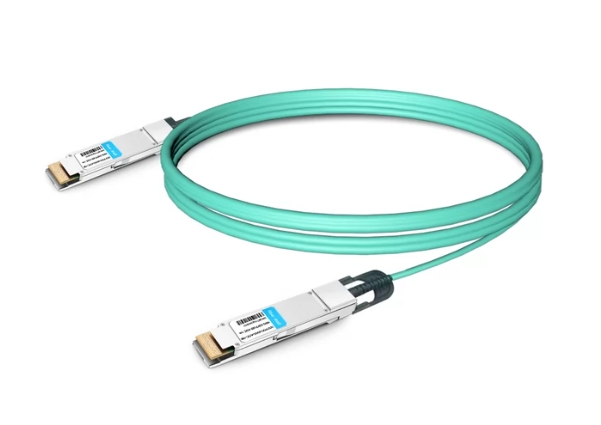
Understanding Breakout AOC
Breakout Active Optical Cables (AOCs) are cables that connect several devices in high-density environments and allow a single connection to be divided into many outputs for easier data sharing. This feature is very useful in data centers where space is limited, and efficient cabling solutions are needed. A QSFP-DD port can link with multiple low-speed ports, such as SFP28 or SFP+, through breakout AOCs, thereby maximizing bandwidth use while reducing cable congestion. Their main applications include interconnecting switches, routers, and servers in HPC settings as well as SANs.
Applications in Network Infrastructure
Breakout Active Optical Cables (AOCs) are very important in improving the efficiency and performance of network infrastructures. These cables find application in different parts of the network structure; data centers, enterprise networking, cloud services among others. AOCs connect core components like switches and servers over large distances at high bandwidth with low latency making them suitable for use in large scale environments where performance is critical.
In large data centers, inter-device latency can be reduced significantly by using QSFP-DD AOC breakout cables which can support up to 400 Gbps due to their ability to transfer data at a very fast speed. Compared to traditional copper cables, it has been shown that power consumption when using an active optical cable (AOC) is about 30% lower, enabling more energy-efficient systems. Likewise, the inclusion of AOCs allows for flexibility within changing network architectures, such as implementing 40G or 100G Ethernet, so that infrastructure remains scalable under increasing demand for bandwidth.
Moreover, milliseconds can tip off competitive advantages, which is why these low-latency and highly dependable devices boost transaction speeds and overall system performance in high-frequency trading as well as financial services. In order to align themselves with modern needs for adaptable and effective networking solutions, businesses should make use of AOCs since they simplify cabling processes, thereby optimizing network topologies while increasing operational resilience.
Performance in High-Density Data Centers
Cooling effectiveness, power management, and the type of interconnect technology are among other factors that influence performance in high-density data centers. Industry experts recommend using advanced cooling solutions such as liquid cooling or hot aisle/cold aisle containment to improve server rack thermal performance significantly. This can enable higher-density configurations without compromising reliability. Also, intelligent power distribution units (PDUs) can be used to monitor and distribute energy more efficiently across high-density deployments, which reduces downtime risk due to power overloads.
In addition, active optical cables (AOCs) have been found to allow for faster data transfer with lower heat generation while increasing energy efficiency. Overall system throughput is improved by these strategies since they lead to reduced latency and enhanced resource utilization — all critical for modern applications like cloud computing or big data analytics. Such performance improvements make it easier for rapidly changing data environments to scale up and adapt quickly.
What are the Key Features of a 400G QSFP-DD AOC?
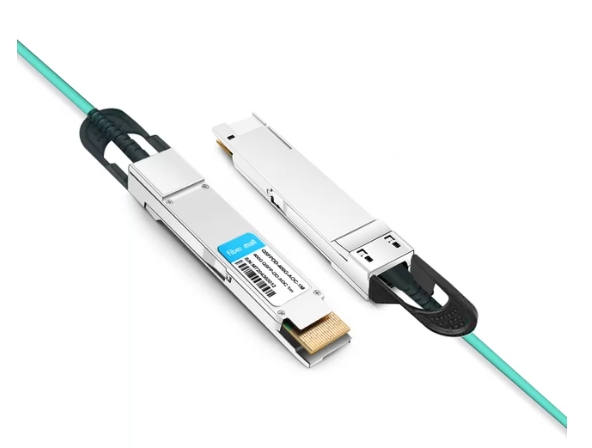
Technical Specifications
The 400G QSFP-DD AOC is built for data-heavy environments such as high-performance computing, storage area networks, and cloud computing. Its main features are listed in the table below:
- Data Rate: Up to 400 Gbps aggregate.
- Connector Type: QSFP-DD (Quad Small Form-factor Pluggable Double Density).
- Distance: The transmission distance is up to 100m on OM4 multimode fiber and 200m on OM5 multimode fiber.
- Wavelength: 850 nm.
- Power Consumption: Less than 3.5W per port, ideal for energy-efficient data centers.
- Transmitter Technology: Parallel optics technology with 4x100G transmission.
- Operating Temperature: -40°C to +85°C.
- Bend Radius: A minimum bend radius of 30 mm design allows for flexible routing in high-density installations.
Based on these specifications, it can be concluded that it is perfect for scalable networking solutions at modern data centers where enhanced performance is required.
Compliance with Industry Standards
The 400G QSFP-DD Active Optical Cable (AOC) is designed to meet various industry standards, ensuring compatibility and reliability in different networking environments. It follows these significant standards:
- IEEE 802.3bs: Defines the specifications for 400G Ethernet to guarantee interoperability with wider network devices.
- SFF-8665: This document specifies the QSFP-DD form factor and ensures that cable dimensions and performance criteria are met for easy integration.
- RoHS Compliance: This indicates that the product does not contain any hazardous materials, thus promoting environmental safety.
- ISO/IEC 14763-2: It gives guidelines on how to design and implement cabling systems in data centers.
By conforming to such industry standards, the performance of the 400G QSFP-DD AOC is guaranteed while also making it easier to use within existing infrastructure which meets high-capacity data transmission demands.
How do you implement QSFP-DD AOC in a data center?
Installation and Maintenance Tips
To ensure peak performance and longevity in a data center environment using 400G QSFP-DD Active Optical Cable (AOC), it is important to follow the installation and maintenance best practices. Here are some detailed pointers:
- Pre-Installation Checks: Check the cable for any physical damages before installation. Make sure connector housings and fiber ends are clean from dirt, dust, or scratches.
- Cable Management: To avoid excess bending or strain on cables, maintain proper cable management. Ensure that AOC is protected against mechanical stressors as well as environmental factors by utilizing trays and ducting. In order to prevent signal degradation during routing, always adhere to minimum bend radius of 30 mm.
- Temperature Control: The specified temperature range within which it should operate is -40°C – +85°C. Regularly check temperature conditions inside the server room/data centers using environmental monitoring systems so that overheating does not occur, compromising the performance of the cable.
- Connection Techniques: When connecting AOC with port interfaces, connectors must be firmly seated but carefully. Excessive force should not be used, as this can damage optical interfaces.
- Regular Inspections: Schedule routine inspections and maintenance of AOC installations. Look out for signs like wear and tear, secure connections, and electromagnetic field sources that could interfere with them, including damaged enclosures.
- Documentation: Keep meticulous records about installations carried out, such as lengths used, sections placed etc., along with any maintenance done on them. This documentation helps in troubleshooting future upgrades, among others.
According to data center operators who follow them, these tips will help improve the reliability and efficiency of networking solutions powered by 400G QSFP DD AOC.
Best Practices for Optimal Performance
To get the best performance from active optical cables (AOCs), try these best practices:
- Quality Components: Use top-notch AOCs that meet industry standards. Ensure compatibility with existing hardware by verifying that cables comply with specifications such as IEEE 802.3 and SFF standards.
- Proper Installation Techniques: Follow manufacturer guidelines during installation, making sure the AOC is securely fastened but not too tightly. Best practices for routing and securing cables should be followed, avoiding sharp corners and excessive torque, which could stress the cable.
- Regular Performance Testing: Periodic performance testing should be done to monitor data integrity and speed. Optical time-domain reflectometers (OTDR) are tools that can help assess the health of AOC links over time.
- Environmental Controls: Optimal environmental conditions must be maintained, including humidity and dust control, which are critical in preventing degradation of both cables and connectors used with them.
- Firmware Updates: Transceivers and connected devices should have latest firmware updates as they can improve compatibility between them as well as enhance performance when it comes to using AOCs.
Data center operators can maximize the efficiency, reliability, and longevity of their installations by adhering to these best practices for active optical cables.
Compatibility with Existing Infrastructure
When incorporating active optical cables (AOCs) into existing infrastructure, there are a number of considerations that must be taken into account in order to ensure seamless integration.
- Standard Compliance: It is important to check whether the AOC meets relevant standards such as Ethernet (IEEE 802.3) and Fibre Channel standards. This will help guarantee that new AOCs can work with legacy systems.
- Connector Types: Successful integration relies heavily on compatibility with connector types used in the current infrastructure. AOCs come with many different connectors, including LC and MTP/MPO, among others, so assessing these will determine which options are suitable for your environment.
- Link Distance and Data Rate Requirements: Existing network equipment should be evaluated for maximum link lengths and required data rates. Different configurations support different lengths/speeds; hence, it is crucial to match them against hardware capabilities available at any given time.
Network administrators can effectively incorporate AOCs into their setups by addressing all of these issues, thereby increasing bandwidth without compromising overall system integrity.
Reference Sources
Frequently Asked Questions (FAQs)
Q: What is a 400G QSFP-DD AOC?
A: The 400G QSFP-DD AOC, which stands for Active Optical Cable, is an ultra-fast data transfer cable primarily used in data centers for applications requiring 400 Gbps Ethernet. It leverages active electrical components to convert electrical signals into optical signals, allowing long-distance and high-bandwidth communication.
Q: How does a 400G QSFP-DD AOC differ from a DAC?
A: The difference between a Direct-Attach Cable (DAC) and the 400G QSFP-DD AOC lies in its ability to convert electrical signals into light waves, which consequently reduces electromagnetic interference while increasing transmission distances. Typically made of copper, DACs can only be used over short distances, unlike AOCs.
Q: What are the benefits of using a 400G QSFP-DD AOC in data centers?
A: These cables would benefit high-density environments that require easy installation and maintenance due to their larger bandwidth capability, longer transmission distances (over one hundred meters), and lesser signal disturbance, among other things.
Q: Can other transceivers like SFP or XFP work with the 400G QSFP DD AOC?
A: No, they cannot because this type of cable was specifically designed for use with the form factor of QSSP-DDS but works fine with some backward-compatible varieties like SFPX, which are capable of connecting different types of transceivers through their breakouts and DACs.
Q: Which applications are suitable for the 400 Gbps QSFPSDD AOCs?
A: Workloads that involve fast data movement within data centers, enterprise networking systems developed on cloud computing platforms, and high-performance computing environments are examples of where these devices would be most beneficial since they allow for greater bandwidth at further ranges.
Q: Are 400G QSFP-DD AOCs compliant with MSA standards?
A: Absolutely, 400G QSFP-DD AOCs adhere to Multi-Source Agreement (MSA) guidelines, which guarantees that they can work together and match a wide variety of networking gear from different manufacturers.
Q: Do 400G QSFP-DD AOCs have the ability to support both 400G networks and current 100G networks?
A: Indeed, it is true that these cables are capable of supporting four hundred gigabit networks. They typically also allow backward compatibility with existing one hundred gigabit systems through DAC breakout cables or other interconnect solutions.
Q: What exactly are QSFP56 breakout cables?
A: Breakout connections made using QSPF56 cables convert a single connection operating at four hundred Gbps into multiple lower speed links such as four one-hundred Gbps links. This becomes necessary when there is a need for backward compatibility between higher-speed and lesser-speed network elements.
Q: Is there any difference between consumer electronic active optical cables and data center active optical cables like the ones used in the 400G QSFP – DD system?
A: Yes, indeed; consumer electronics usually operate over shorter distances than enterprise-level devices, thus having lower bandwidths. They are designed specifically to meet this requirement, whereas data center active optical cords, including those classified under the category of QSPIF—DD, are made to handle high-speed communications over long distances within enterprises.
Q: Why should we care about qsfp-dd msa concerning four hundred gigabits per second qsfps?
A: MSA defines specs/standards applicable to transceivers involving different ports among various manufacturers so that all resulting appliances will be compatible regardless of brand differences, especially during installation phases within data centers and high-performance computing environments.
Related Products:
-
 QSFP-DD-400G-AOC-1M 1m (3ft) 400G QSFP-DD to QSFP-DD Active Optical Cable
$655.00
QSFP-DD-400G-AOC-1M 1m (3ft) 400G QSFP-DD to QSFP-DD Active Optical Cable
$655.00
-
 QSFP-DD-400G-AOC-2M 2m (7ft) 400G QSFP-DD to QSFP-DD Active Optical Cable
$660.00
QSFP-DD-400G-AOC-2M 2m (7ft) 400G QSFP-DD to QSFP-DD Active Optical Cable
$660.00
-
 QSFP-DD-400G-AOC-3M 3m (10ft) 400G QSFP-DD to QSFP-DD Active Optical Cable
$665.00
QSFP-DD-400G-AOC-3M 3m (10ft) 400G QSFP-DD to QSFP-DD Active Optical Cable
$665.00
-
 QSFP-DD-400G-AOC-5M 5m (16ft) 400G QSFP-DD to QSFP-DD Active Optical Cable
$670.00
QSFP-DD-400G-AOC-5M 5m (16ft) 400G QSFP-DD to QSFP-DD Active Optical Cable
$670.00
-
 QSFP-DD-400G-AOC-7M 7m (23ft) 400G QSFP-DD to QSFP-DD Active Optical Cable
$680.00
QSFP-DD-400G-AOC-7M 7m (23ft) 400G QSFP-DD to QSFP-DD Active Optical Cable
$680.00
-
 QSFP-DD-400G-AOC-10M 10m (33ft) 400G QSFP-DD to QSFP-DD Active Optical Cable
$690.00
QSFP-DD-400G-AOC-10M 10m (33ft) 400G QSFP-DD to QSFP-DD Active Optical Cable
$690.00
-
 QSFP-DD-400G-AOC-15M 15m (49ft) 400G QSFP-DD to QSFP-DD Active Optical Cable
$710.00
QSFP-DD-400G-AOC-15M 15m (49ft) 400G QSFP-DD to QSFP-DD Active Optical Cable
$710.00
-
 QSFP-DD-400G-AOC-20M 20m (66ft) 400G QSFP-DD to QSFP-DD Active Optical Cable
$725.00
QSFP-DD-400G-AOC-20M 20m (66ft) 400G QSFP-DD to QSFP-DD Active Optical Cable
$725.00
-
 QSFP-DD-400G-AOC-25M 25m (82ft) 400G QSFP-DD to QSFP-DD Active Optical Cable
$750.00
QSFP-DD-400G-AOC-25M 25m (82ft) 400G QSFP-DD to QSFP-DD Active Optical Cable
$750.00
-
 QSFP-DD-400G-AOC-30M 30m (98ft) 400G QSFP-DD to QSFP-DD Active Optical Cable
$755.00
QSFP-DD-400G-AOC-30M 30m (98ft) 400G QSFP-DD to QSFP-DD Active Optical Cable
$755.00


